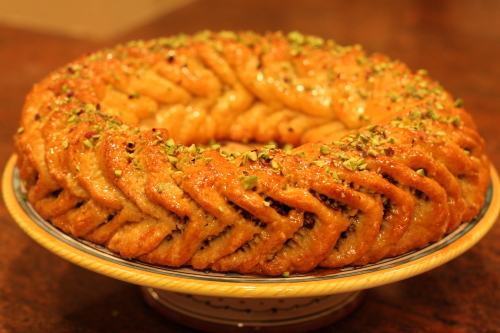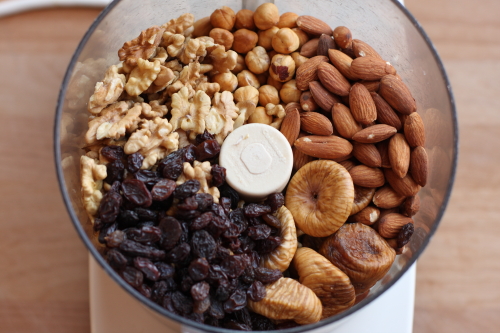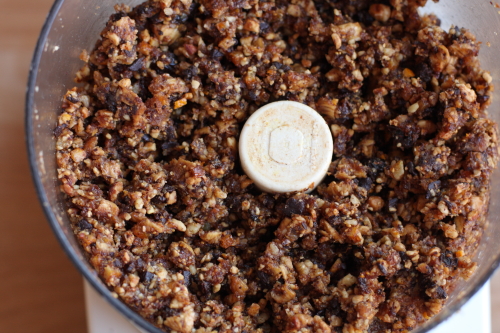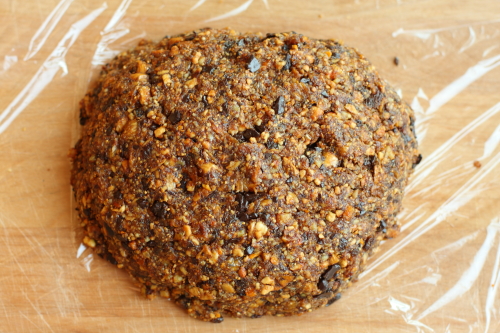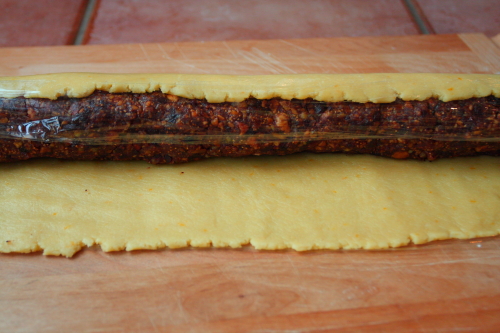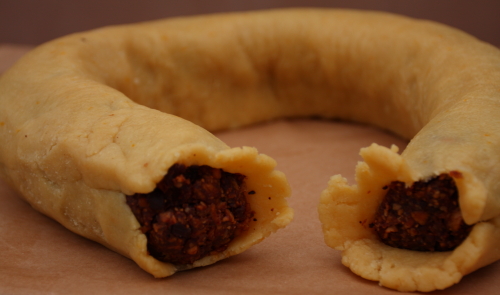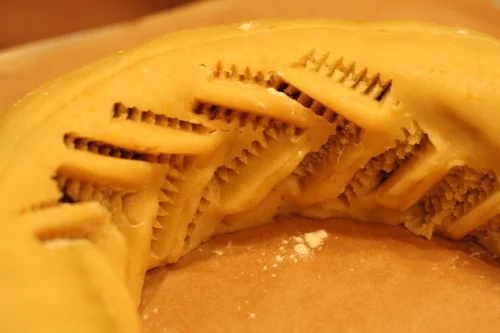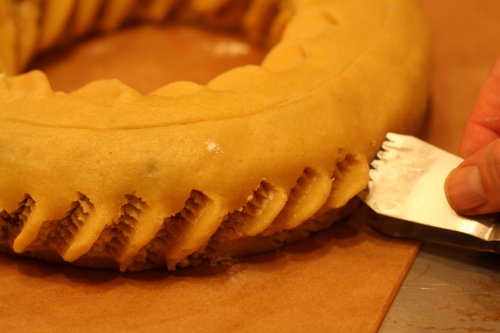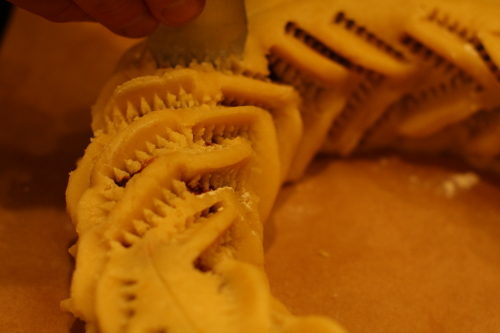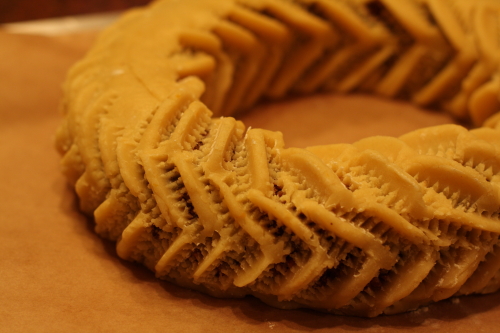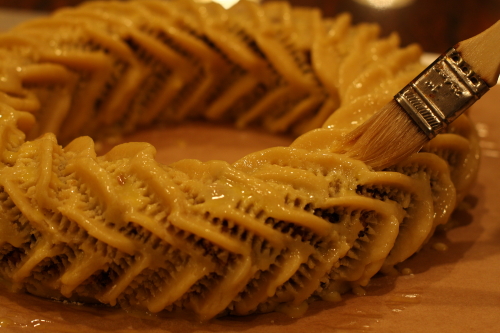Buccellato Siciliano (Christmas Fig and Nut Pastry Ring)
This year I would like to share with you a traditional dessert that is prepared in Palermo, Sicily for Christmas – Buccellato. Think of the Buccellato as a super-sized fig cookie. The smaller size of this pastry is called Cucciddati or Buccellatini. I think it is more impressive (and easier) for the Christmas table to prepare one Buccellato than a dozen small cookies. If you choose to make the fig cookies, use the same dough and filling, but shape them in small cookies using the same technique (wrap the filling around the dough and cut in small pieces).
I did not include this dessert in my latest cookbook Southern Italian Desserts, as I did not have the right tool to decorate the Buccellato like they do in the pastry shops in Palermo. This past summer when I was in Palermo I bought a pinza (crimper), so that I could make a Buccellato for Christmas. You can still make and enjoy it for the holidays without having this tool, but I wanted to share how this dessert is made in Palermo. You can use a fork or other kitchen tools (e.g. ice tongs, fondant crimper, use your imagination) to create a pattern to crimp the dough so you expose some of the fig filling. The crimping work (pizzicatura) creates the pattern (ricamo) in the dough, but, I assure you, it will be just as delicious if you use a fork to create a pattern. This was my first attempt at crimping and as you can see from the photos you don’t need to be perfect as the baking process magically transforms the dough into a work of art. I had the help of my assistant Randy to make this decorative pattern around the cake, so I could capture each step with my camera.
I originally used my sister-in-law’s recipe with the traditional filling made in Palermo. As I was testing this recipe, I tried some variations like adding 1/2 cup of jam (you can use fig, orange or apricot), adding 1/3 cup honey, and even adding mosto cotto in place of marsala. The modifications did not result in any significant difference, so I decided to stay with the simple traditional filling, and used my pasta frolla recipe (sweet short-crust dough) that is included in my desserts book. The ingredients that go into the filling are: figs, nuts, raisins, candied orange peel, mandarin peel, orange zest, chocolate, cinnamon, and sweet marsala wine. Some people will also add a pinch of ground cloves. Throughout the island of Sicily each family has their own variation for the filling.
Start making the filling by placing the figs, raisins and nuts in a food processor. You can also chop all the ingredients by hand, but I found that a food processor works well and takes very little time.
Add the remaining ingredients (notice that I chopped the chocolate and candied orange peel and minced the mandarin zest) and pulse until all the ingredients are well mixed. Don’t over blend the filling as you want some texture; it should resemble a coarsely chopped mixture.
Place the filling in a bowl and knead it till it comes together to make a sticky filling. Refrigerate, covered with plastic wrap, for a couple of hours or overnight. The filling can be made ahead up to two days ahead of time.
Follow the recipe for the pastry dough and shape it into a rectangle 9 inches by 4 inches, and wrap it in plastic wrap and place in the refrigerator.
Roll out the pastry dough in between two pieces of plastic wrap into a rectangle of 23 inches long by 8 inches wide. Place the dough in the refrigerator while you shape the filling.
Place the filling on top of plastic wrap and using your hands shape it into a log. Wrap it with the plastic and roll it to look like a salame, about 22 inches long and 2 inches in diameter. The fig “salame” is encased in the pasta frolla and shaped into a ring.
Follow the instructions in the recipe for the details on how shape, seal and crimp the Buccellato. The following pictures will guide you and should be easy to associate with the written steps in the recipe.
The crimping process begins:
Once the shaping and crimping is finished, refrigerate the Buccellato for a couple of hours or overnight. Before baking it, brush the entire Buccellato with an egg wash using a pastry brush.
Bake at 375 F (190 C) for about 30 minutes or longer for the dough to turn a golden color all over.
Let it cool for 15 minutes and brush the entire cake with the jam glaze. Decorate by topping the Buccellato with chopped pistachios. Buccellati can also be decorated with candied fruit or sprinkles.
Here is what the inside looks like. Each slice is equal to eating a cucciddati (small fig cookie).
I hope you give it a try, and don’t worry about the crimping work, as it will be delicious even with a simple pattern created with a fork. If you do make one, please share a picture of your finished Buccellato on my Facebook page.
Buon Natale!
Buccellato (Christmas Fig and Nut Pastry Ring)
Ingredients
One egg for egg wash
Pasta frolla (sweet short-crust pastry)
3 cups (396 g) unbleached all-purpose flour
3/4 cup (150 g) sugar
1 teaspoon baking powder
1/4 teaspoon kosher salt
3/4 cup (170 g) unsalted butter, chilled
2 large eggs
Grated zest of 1 lemon
Filling:
One pound (454 g) dried Kalamata or Calimyrna figs
2/3 cup (100 g) toasted almonds
1 cup (100 g) walnuts
3/4 cup (100 g) toasted hazelnuts
1/2 cup packed raisins (100 g)
3.5 ounces (100 g) dark chocolate finely chopped or chocolate chips
2 ounces (55 g) candied orange peel, finely chopped
1 tablespoon grated orange zest
1 tablespoon mandarin zest, minced
1 teaspoon ground cinnamon
1/2 teaspoon ground cloves (optional)
1/2 cup sweet marsala or mosto cotto
Glaze
¼ cup apricot or orange jam
One tablespoon of water
Garnish
Two tablespoons chopped raw pistachios, for garnish
Making the Pasta Frolla (Pastry Dough):
Combine the flour, sugar, baking powder, and salt in a food processor and pulse just a few times to combine them. Cut the butter into small cubes, about sixteen per stick, and add them to the food processor. Pulse until the butter is in small crumbs. Whisk the eggs with the lemon zest in a small bowl. With the machine running, add the eggs through the feed tube. Mix, then pulse a few times, until the mixture comes together around the blade. When you stop the mixer and pinch it between your fingers, the dough should hold together easily.
Lay out a sheet of plastic wrap on a flat surface. Transfer the dough to the plastic wrap and press it together with your hands to form a smooth ball.
Flatten the dough into a rectangle about 9 inches long and 4 inches wide. Wrap tightly in plastic film, and refrigerate for at least 30 minutes, or up to 3 days, before rolling.
Making the Filling:
Remove all the stems from the dried figs. If the figs are very dry you can soak them in hot water for 15 minutes to plump up, but if the figs are very moist you can skip this step.
Place the figs, nuts and raisins in a food processor and process until the nuts and figs are coarsely chopped. You will need a large food processor bowl to hold this mixture. If you have a small food processor, split it in two batches and then combine after grinding.
Add the remaining ingredients and pulse until well combined, don’t over blend the filling as you want some texture; it should resemble a coarsely chopped mixture.
Place the filling in a bowl and knead it till it comes together to make a sticky filling. Refrigerate covered with plastic wrap for a couple of hours or overnight. The filling can be made ahead up to two days ahead of time.
Shaping the Buccellato:
Remove the pastry dough from the refrigerator. If refrigerated for more than an hour, let stand wrapped, at room temperature for 30 minutes before rolling.
Roll out the dough in between two pieces of plastic wrap to a rectangle of 23 inches long by 8 inches wide. Place the pastry dough with the plastic wrap on top of a baking sheet and place in the refrigerator while you shape the filling.
Place the filling on top of plastic wrap, and use your hands to shape it into a log. Wrap it with the plastic and roll it to look like a salame, about 22 inches long and 2 inches in diameter.
Remove the plastic wrap from the top of the dough leaving the bottom piece and place the filling in the middle of the pastry dough rectangle. Using the bottom sheet of plastic wrap to assist, bring the long sides of the dough pieces together, completely encasing the filling, and seal. Place the dough with the seam down and roll it gently to completely seal the seam, keeping the ends open. Remove the plastic wrap, and place the log on top of a baking sheet lined with parchment paper. Shape the log into a ring. You may need to gently, and evenly elongate the dough by rolling it back and forth in order to bring the two ends close together to form a ciambella (ring shaped). Fit one end of the pastry inside the other so that the filling from the two ends is touching, and then seal the dough. Massage it all around to get an even, round ring of dough about 10 inches in diameter. If the dough gets too soft or sticky, place it in the fridge until it firms up and then finish shaping.
Once the Buccellato is shaped, place it in the fridge for an hour before you start the crimping work, as the dough needs to be cold but still pliable. If it is too stiff, let it sit out for 15 minutes until it is pliable. Using the Pinza or whatever you can find in your kitchen (e.g. ice tongs, fondant crimper, or even a fork) start creating the pattern.
To make the traditional pattern, inscribe a circle around the center of the top of the dough as a guide, an 8 inch cake ring makes a great template. Starting on the inside of the ring, pinch the dough at a 45 degree angle (leaning right) around the bottom half of the inside. You want to crimp deep enough to expose some of the filling, and gather the dough inside the crimper to form a ridge. Dip the crimper in a small dish of flour, as needed, to prevent the dough from sticking to the crimper. On the top half of the inside, crimp the dough at a 45 degree angle in the opposite direction to create a sideways "V" pattern. Repeat the same pattern on the outside of the dough, exactly as done on the inside - the "V"s will go in opposing directions. The top of the ring will still be smooth. Finally crimp the top of the dough at an angle, aiming to connect the end of an outside "V" with an inside one. Do not worry if there are more "V"s on the outside or inside, just try to maintain a consistent angle and spacing. Continue until the top has been crimped all around. Follow the pictures to see the pattern.
Once done, refrigerate it for a couple of hours or overnight.
When you are ready to bake, preheat the oven to 375 F (190 C) with a rack in the middle of the oven. It is important that the dough is chilled and the oven is hot, to minimize the pasta frolla from “drooping” while it sets during baking. (Some drooping is normal)
Remove the pastry ring from the refrigerator and before baking it, brush the entire Buccellato with an egg wash using a pastry brush. Bake at 375 F (190 C) for 30 to 35 minutes or longer for the dough to turn a golden color all over. Rotate the pan as needed to insure an even color after 20 minutes of baking, continue baking until the dough is golden color.
Let the Buccellato cool for 15 minutes. While it is cooling prepare the jam glaze. Put the jam in a small pot with a tablespoon of water and heat it over medium heat until melted and liquid. Remove from the heat and strain the jam through a fine strainer to remove any lumps. Glaze the entire Buccellato using a pastry brush. Finish decorating by sprinkling the top of the Buccellato with chopped pistachios; Buccellati can also be decorated with candied fruit or sprinkles.
Before slicing, let the Buccellato cool completely.
Makes one 12 inch ring buccellato (about 3 lbs, 1.5 kg)
The Pasta frolla recipe is “Reprinted with permission from my cookbook “Southern Italian Desserts: Rediscovering the Sweet Traditions of Calabria, Campania, Basilicata, Puglia, and Sicily, (Ten Speed Press, © 2013).

